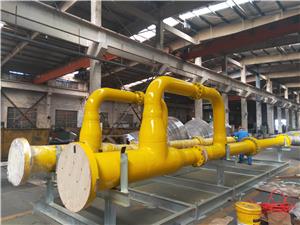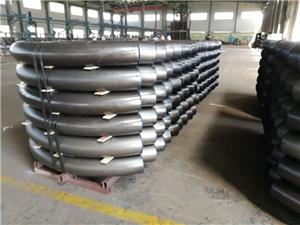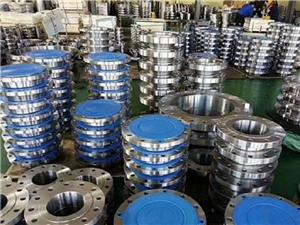A tompahegesztett csőszerelvények anyagi ionjaira vonatkozó alapelvek és szempontok
Butt welded pipe fittings are connected to pipelines through welding and have the advantages of firm connection, good sealing, and strong pressure-bearing capacity. However, different working environments and process requirements make the material selection of butt welded pipe fittings complex and diverse. Therefore, when making material selection, multiple factors must be conside red to ensure that the selected material can meet actual needs.
1.Media characteristics
Corrosive media:
For pipeline systems transporting corrosive media, the materials must have good corrosion resistance. Commonly used materials include stainless steel and corrosion-resistant alloys.
Stainless steel: such as 304 and 316L stainless steel, suitable for transmitting highly corrosive media such as strong acid and strong alkali.
Corrosion-resistant alloys: such as Hastelloy and titanium alloys, are suitable for extreme corrosive environments and have excellent corrosion resistance.
Non-corrosive media:
For non-corrosive media, such as water, oil, gas, etc., lower-cost materials can be selected.
Carbon steel: such as Q235, A106, suitable for general non-corrosive media.
Low alloy steel: such as 16Mn, 12CrMo, suitable for moderately corrosive environments, with good mechanical properties and certain corrosion resistance.
2. Operating temperature
High temperature environment:
In high temperature environments, pipe fitting materials need to have good heat resistance and oxidation resistance.
Heat-resistant steel: such as Cr-Mo steel (P11, P22), suitable for high-temperature steam pipes and boiler pipes.
Nickel-based alloys: such as Inconel and Hastelloy, are suitable for extremely high temperature environments and have excellent high temperature resistance and oxidation resistance.
Low temperature environment:
In low or ultra-low temperature environments, pipe fitting materials need to have good low-temperature toughness to prevent low-temperature brittle fracture.
Low-temperature steel: such as 9Ni steel, suitable for low-temperature environments, such as liquefied natural gas (LNG) pipelines.
Austenitic stainless steel: such as 304 and 316L stainless steel, which are suitable for low temperature environments and have excellent low temperature toughness.
3. Work pressure
High pressure environment:
High-pressure environments place higher requirements on the strength and toughness of pipe fitting materials.
High-strength alloy steel: such as P91 and P92, suitable for high-pressure steam pipes and boiler pipes.
Stainless steel and nickel-based alloys: used in high pressure and corrosive environments to provide high strength and corrosion resistance.
Low pressure environment:
Low-pressure environments have relatively low material strength requirements, so lower-cost materials can be selected.
Carbon steel and low alloy steel: such as A106 and 16Mn, which are suitable for general low-pressure pipeline systems and have sufficient strength and toughness.
4. Mechanical properties
Strength and Hardness:
For applications requiring high strength and hardness, choose high-strength steel.
High-strength steel: such as alloy steel (42CrMo, 35CrMo), suitable for high stress and high wear environments.
Tough materials: such as austenitic stainless steel (304, 316L), suitable for occasions requiring high toughness, such as low temperature environments.
Plasticity and ductility:
For applications requiring high plasticity and ductility, choose materials with good molding properties.
Mild steel: such as low carbon steel (Q235), suitable for occasions requiring high plasticity and ductility, and easy to form and weld.
5. Welding performance
Ease of welding:
Choosing materials that are easy to weld can simplify the welding process and improve welding quality.
Carbon steel and low alloy steel: such as Q235 and 16Mn, are easy to weld and suitable for general welding processes.
Austenitic stainless steel: such as 304 and 316L, has good welding performance and is widely used in occasions requiring high welding quality.
Special welding requirements:
For materials that are difficult to weld, special welding processes and welding materials are required.
High alloy steel and nickel-based alloys: such as Inconel and Hastelloy, are more difficult to weld and require professional welding processes and welding materials.
6. Economical
Cost Control:
On the premise of meeting performance requirements, lower-cost materials should be selected as much as possible to control project costs.
Carbon steel: such as Q235, low cost and suitable for large-scale use.
Alloy steel and stainless steel: such as P91 and 316L, although the initial investment is high, they have high cost performance under certain circumstances.
Service life:
Considering the service life and maintenance costs of materials, choosing materials with good durability can reduce long-term operating costs.
Corrosion-resistant materials: such as stainless steel and corrosion-resistant alloys, the initial investment is high, but the service life is long and the maintenance cost is low.
7. Other factors
envirnmental factor:
According to the special requirements of the use environment, select materials that adapt to the specific environment.
Low temperature brittleness: In low temperature environments, materials with good low temperature toughness should be selected, such as austenitic stainless steel.
High-temperature oxidation: In high-temperature environments, materials with anti-oxidation properties should be selected, such as heat-resistant steel.
Standards and Specifications:
Material selection should comply with relevant international and national standards and specifications to ensure its safety and reliability during use.
International standards: such as ASTM, ASME standards.
National standards: such as GB, JB standards.



